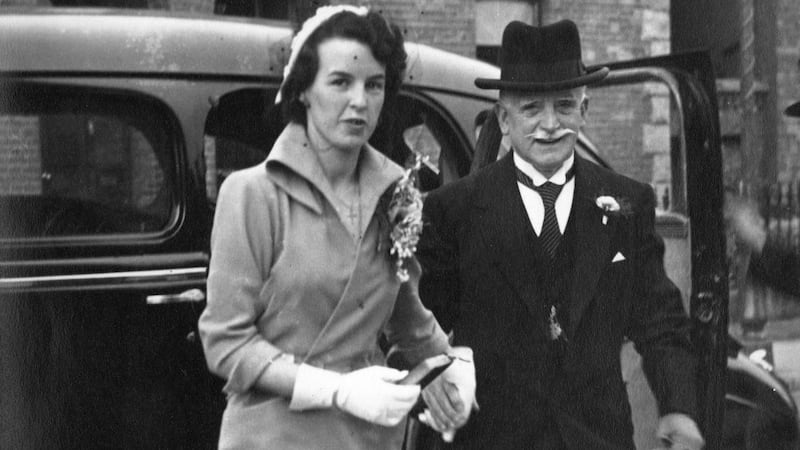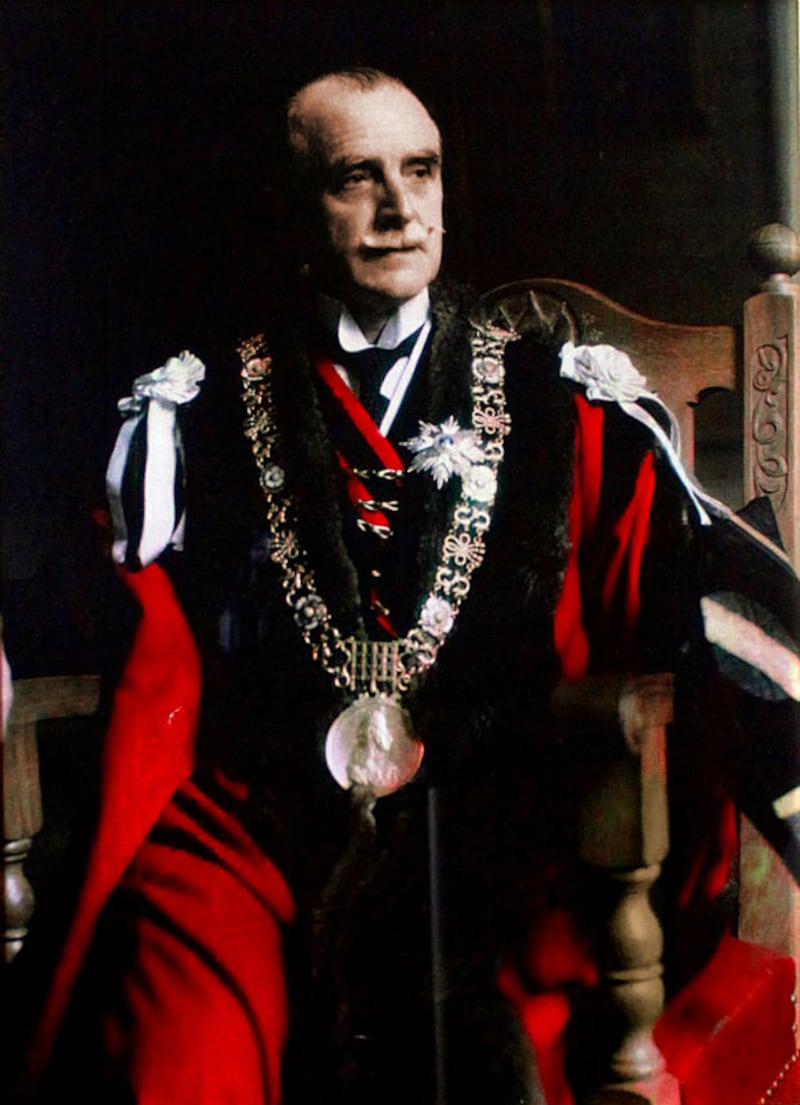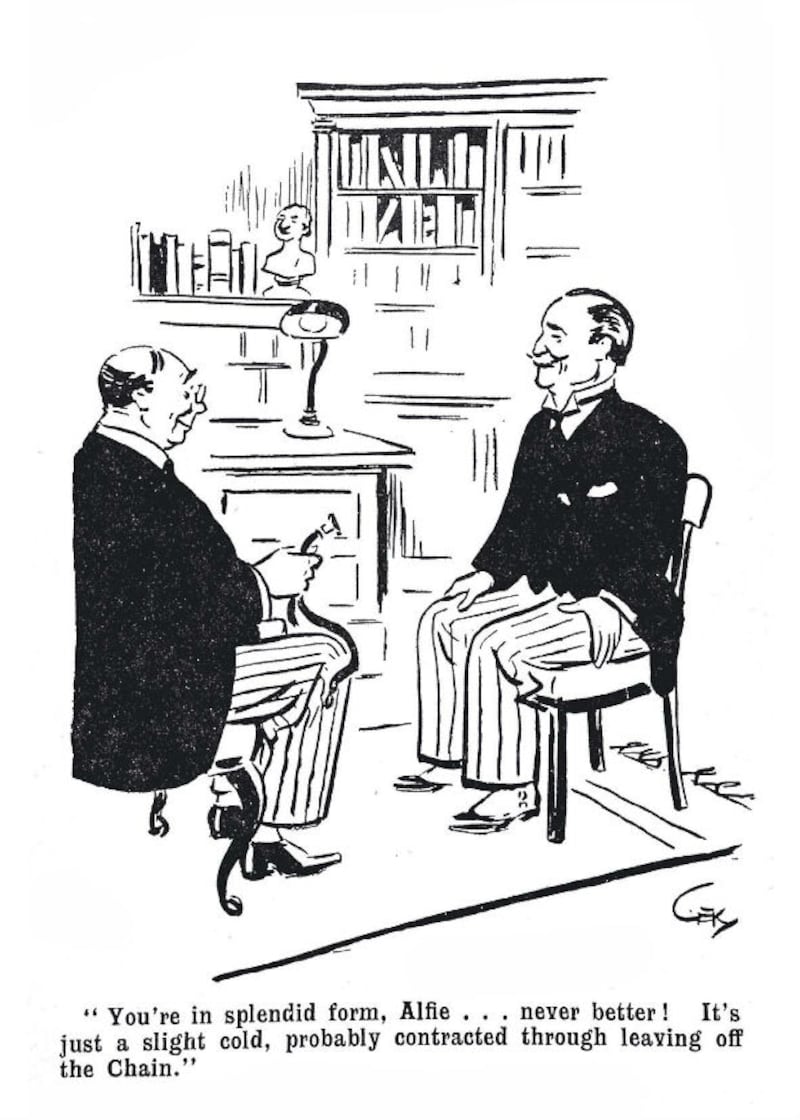In October 1930, Alfie Byrne took office as lord mayor of Dublin. He was 48 years old, and an elected official of long standing: he had served, pre-Independence, as a Westminster MP, and subsequently as a Deputy in Dáil Éireann, and he was a sitting Senator.
On moving into the Mansion House, Byrne became the first (and still only) politician to serve in all four capacities. But it was as lord mayor that he made himself a historic figure.
From the start he took an expansive view of the role. Dublin Corporation supplied only a secretary and a steward, so Byrne hired an additional secretary, a chauffeur and three maids. He also ordered repairs to the Mansion House that cost £5,000.
In City Hall Jim Larkin complained when it was revealed that the annual salary for the lord mayor would rise from £1,600 to £2,500, but it was ruled that the figure was specified in a contract between Dublin Corporation and the mayor, and could not be altered.
Byrne would be the highest-paid politician in the country, a measure of his negotiating skills and the prestige attached to the job. In some mysterious way the publicity surrounding his salary made him more magnetic, as if the people of Dublin felt his riches might rub off on them.
Pied Piper of Dawson St
Byrne quickly developed a reputation as an expert on bread and circuses. One of his early gambits was to entertain school children at tea parties in the Mansion House. More than 2,000 children enjoyed cocoa and cake at the first Christmas feast, everyone was presented with a personalised box of Urney chocolates at the end, and there were even special trams to take the young guests home.
The Evening Mail told readers that the lord mayor was bringing "at least one day of real joy to the hearts of the little ones, too many of whom are doomed to live the best part of their lives in squalid and unhealthy surroundings".
A seminal figure in the history of pester power, Byrne used children to do his bidding in a way that would raise concerns today – urging them, for example, to canvass their parents at the kitchen table. At one election children stood outside voting booths with photographs of the lord mayor around their necks.
And for many years a schoolyard chant included the words, “cheer up, Alfie Byrne is knocking at the door”.
In Terence Dolan's Dictionary of Hiberno-English, the Irish tradition of the "grush" is defined as "a scramble by children to get coins or other small gifts thrown at them". When children ran up to Byrne he doled out sweets – bull's-eyes, perhaps, lollipops or lemon drops – as a way to produce a public sensation.
At that time sweets were among the few accessible luxuries in Free State Ireland, and domestic production increased in the 1930s after Fianna Fáil put a tariff on English imports. (Unlike most pleasures, eating candy was not then considered a mortal sin; chocolate and ice cream were even marketed for their nutritional value).
Byrne, the Pied Piper of Dawson Street, loved sweet things, and he also liked an audience.

While Byrne enchanted the youth of Dublin, he was largely absent as a father. “We didn’t see that much of him,” recalls his son Patrick.
Alfie’s wife, Cissie, often took the children on holiday without their father, and Patrick never saw his father in anything other than a stiff collar. There is a photograph of Byrne on a beach with his family. He is dressed for City Hall.
Morning suit
On Sundays Byrne woke up in the Mansion House, put on his morning suit, had breakfast with his wife, read the papers and went to Mass in the Pro-Cathedral. Then he met his older brother Lar and some other pals under Clerys clock on O’Connell Street.
A street-trader, seeing the lord mayor there one day, went down on one knee, sweating the words, “Oh my lordship, my lordship!” Byrne restored the woman to her feet, and said: “It’s Alfie to you, as usual, Sally.”
She pointed to a bag of potatoes, and said “give us a hand with these spuds, Alfie”.
Like many stories about Byrne, this may be apocryphal even as it speaks to something authentic; in this case a mixture of grandeur and self-effacement.
In the 1930s the Irish were insatiable readers of newspapers, and Byrne played the press well. He treated pressmen like esteemed clients, he knew there was no point leaking good news at a time when the attention of the public was consumed by some momentous event.
When a monoplane was exhibited at Baldonnel airfield, Byrne climbed into the machine for a short flight in strong winds and rain. The pilot asked if he really wanted to make the trip.
“Certainly,” he said. “I always wondered what it was like in one of these things in bad weather. Now I can find out.”
This image of Byrne as the gallant stuntman of Irish politics soon took hold in the public imagination. Why would the lord mayor stand with a pair of scissors to open Butt Bridge when he could cycle over the bridge and cut the ribbon at top speed followed by several hundred other cyclists?

Like a comic-book hero, Byrne seemed to be first on the scene of any disaster – even if it was not in Dublin.
When the town of Clones in Co Monaghan was engulfed in a fire one night in December 1930, Dublin Fire Brigade offered to assist. The lord mayor donned a protective uniform and took a seat on the fire engine as it left Dublin for Clones. The image made for a popular cartoon that Christmas.
On returning to the capital, Byrne claimed, “I have had one of the thrills of my life”. The fire engine had, he said, “created excitement in the several towns through which we dashed. We reached Dundalk in an hour and eight minutes. We touched 70 miles an hour in some places.”
As if to prove that news travels fast, the reported speed of the fire engine soon increased. By that weekend it was 80 miles an hour.
On the night of January 11th-12th, 1931, a water main burst at the junction of Macken Street and Hogan Place, instantly making 50 people homeless. Byrne opened the Mansion House to those affected, and gave them shelter, food and clothes.
Later that year when floods hit parts of Dublin and Bray, Byrne was quick to respond once again, “spending all night touring the hard-hit areas, sympathising, organising, encouraging”. The country’s first leader, WT Cosgrave, presented a cheque for £1,000 as the government contribution to Byrne’s relief fund.
Twiddly moustache
At his first Christmas as lord mayor, Byrne attended so many functions that one journalist wondered if he ever found time to eat dinner. With ceremonial mace and sword, in those famous gold chains of office, the lord mayor lent foppish grandeur to parties, company dinners, gala balls and club dances all over the city.
His signature clothing was largely established by the time he became lord mayor, but something was still missing.
In the first of seven appearances on the cover of Dublin Opinion, he had no facial hair. Yet in January 1931, a twiddly moustache had been grown, to distract attention from the poor condition of Byrne's front teeth; when the teeth were upgraded in 1934 he kept the facial hair until the very end.
The lord mayor’s reputation as a soft touch soon produced a joyless sight. Every morning 10 or 15 men and women queued outside the Mansion House. Most had hard-luck stories about money, disputes, health, housing, jobs or family, and all imagined the lord mayor could provide satisfaction. A critic once said, “no one knows better than Alfie what appeals to the man in the street, particularly the man who does not have to pay the bill”.
But he was a diligent advocate for the city’s poor. A reporter who sat in Byrne’s office as he dictated his morning letters noted that in less than an hour the lord mayor accepted 17 invitations to dinners, one to a play and eight to public functions, in addition to dictating “43 sympathetic letters to men and women looking for employment”. He claimed to receive more than 100 such appeals every day.

Byrne's reputation went far beyond Dublin. A story in The Irish Times reported that he spent more money on postage in a week than any four of his predecessors combined. The article, headed "Lord Mayor's Postbag: 15,000 letters", also formalised a nickname: "The letters come from all of the earth, and often from people who know nothing about Ireland. One letter, whose contents showed it was intended for the Lord Mayor of Dublin, was addressed: 'The Lord Mayor of Ireland, Sligo'."
Byrne liked to spread good news before it became official. One morning he told some lads outside the Customs House: “You boys need a bench.” That afternoon it magically appeared.
When Byrne developed a habit of boarding mail boats to welcome distinguished visitors to Dún Laoghaire, a Fianna Fáil councillor complained that the lord mayor “comes out here to usurp our chairman’s functions”.
The chairman concurred: “I have generally succeeded in being first on the boat, but not having any insignia of office except perhaps a temperance badge, I am not as easily recognisable as a man with links of gold round his neck. I have always preceded him, but he has always managed to get in his speech first.”
Extremely jealous
Byrne’s first term as elected lord mayor came to an end in the summer of 1931. Determined to retain the title, he brokered the support of Cumann na nGaedheal in return for his fealty in the national parliament.
The Belfast Newsletter noted that the loudest opposition to Byrne's re-election was "from Larkinite and other Labour representatives, who are extremely jealous of 'Alfie's' great popularity in the poor quarters of the city".
The paper described Byrne as “a curious study, because apart from his public position he is an absolute nobody. He is unlearned – he is not a big business man; he is not a politician.”
The legend that he was “non-political” was self-perpetuated, but the same piece also identified something genuine. “If you meet him in the street, a dapper little man walking with quick steps, you feel sure that the friendly smile on his face was meant for you. Only the bitterest fanatics can withstand his friendliness. The friendliness is not mere show; ‘Alfie’ has helped hundreds of lame dogs over stiles.”
Byrne presented himself as a simple man with simple desires. All he wanted was jobs, housing, a united Ireland, more playgrounds, Mass on Sunday and a full dance card. It was not the world’s most credible manifesto, and some of those goals would remain beyond his reach.
But on July 1st, 1931, Byrne was re-elected for a second term as lord mayor of Dublin.
Trevor White is the author of Alfie, published by Penguin Ireland




















